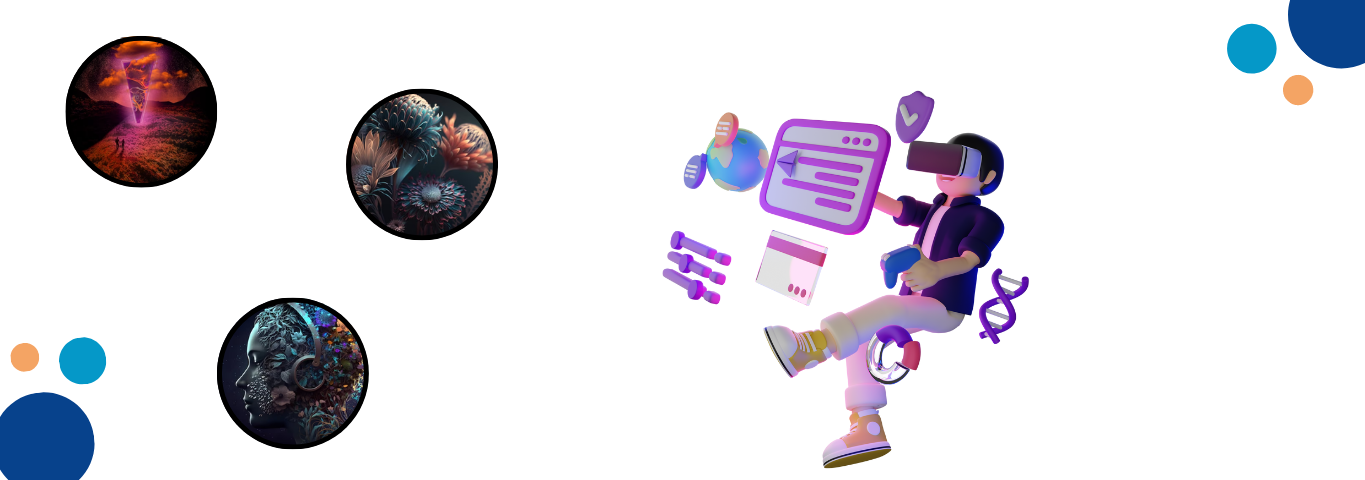
Unleashing Creativity: Exploring the Potential of Generative AI
Published on
16 June 2023
Author
In recent years, the field of artificial intelligence has witnessed remarkable advancements, and one area that has captured the imagination of researchers and creative minds alike is generative AI. Generative AI refers to the application of machine learning algorithms that can generate original and creative content, such as images, music, text, and even entire virtual worlds (Balint & Allbeck, 2017). This emerging technology has opened a world of possibilities, revolutionized various industries, and pushed the boundaries of human imagination.
This blog post will dive into the fascinating world of generative AI and explore its potential for transforming the creative landscape.
Understanding Generative AI
Generative AI uses neural networks, specifically generative models, to create new content that imitates or expands upon existing data patterns (Morizet et al., 2022). These models learn from vast training data to generate new and unique content similar to the data it was trained on. Some popular generative models include Variational Autoencoders (VAEs), Generative Adversarial Networks (GANs), and Transformers.
Variational Autoencoders (VAEs), Generative Adversarial Networks (GANs), and Transformers are three powerful techniques in the field of generative AI. Each of these approaches has unique characteristics and applications, contributing to advancing generative models. Let us explore each of them in more detail.
- Variational Autoencoders (VAEs):
- Generative Adversarial Networks (GANs): Generative Adversarial Networks comprise two competing neural networks: a generator and a discriminator. The generator network aims to generate realistic samples from random noise, while the discriminator network learns to distinguish between actual and generated samples. The generator and discriminator are trained iteratively, with the generator attempting to fool the discriminator and the discriminator improving its ability to differentiate between real and fake samples. GANs excel at capturing complex data distributions and producing high-quality, realistic outputs.
(Overview of GAN Structure | Machine Learning | Google for Developers, no date)
- Transformers:
Variational Autoencoders are generative models that learn latent representations of data. They consist of two main components: an encoder and a decoder. The encoder encodes input data into a lower-dimensional latent space, capturing essential features. The decoder then reconstructs the original input data from the latent representation.
Applications of VAEs include image synthesis, text generation, and anomaly detection. VAEs enable efficient storage and reconstruction of complex data distributions by learning a compressed representation of the data, making them valuable tools in various domains.
Transformers have gained tremendous popularity in natural language processing tasks and have also shown promise in generative AI. Transformers utilize a self-attention mechanism to capture relationships between different input sequence elements.
Transformers have revolutionized machine translation, text generation, and language modeling. They have demonstrated exceptional capabilities in generating coherent and contextually relevant text, leading to advancements in chatbots, language models like GPT-3, and other natural language generation tasks.
Transformers, sometimes called foundation models, are already being used with many data sources for a host of applications. (What Is a Transformer Model? | NVIDIA Blogs, 2022)
Applications in Various Fields
- Art and Design: Generative AI has empowered artists and designers to explore new frontiers of creativity. By leveraging generative models, artists can create mesmerizing and unique visual artworks, enabling them to experiment with different styles, colors, and compositions. Additionally, generative AI can assist in generating novel design concepts, architectural blueprints, and fashion designs.
- Music Composition: Generative AI has found its place in the music world, enabling composers to generate original compositions. By training in vast libraries of existing music, AI models can create new melodies, harmonies, and even entire musical arrangements. This technology has the potential to assist musicians in overcoming creative blocks and discovering fresh musical directions.
A concept of generative AI generated by Midjourney (Navigating the AI revolution: how designers can stay competitive | by Irina Nik | UX Collective, no date)
Aimi is a generative AI music platform (Generative AI Music Platform Creates Forever Songs with Artists Unique Sounds, Melodies, And Beats, no date)
Ethical Considerations
While generative AI offers remarkable potential, it also raises important ethical considerations. For instance, the misuse of generative AI could create and disseminate fake news, deepfakes, and other forms of misinformation. It is crucial to develop robust ethical guidelines and responsible use frameworks to ensure the technology is used in a manner that promotes truth, transparency, and accountability.
Conclusion
Generative AI has emerged as a powerful tool that stretches the limits of human creativity. Its ability to generate original content across various domains has transformed industries and sparked new possibilities for innovation. From art and music to gaming and content creation, generative AI empowers individuals and businesses to explore uncharted territories and unlock new levels of imagination.
As we move forward, it is essential to navigate the ethical considerations and responsibly shape generative AI development. Ultimately, generative AI has the potential to inspire, enhance, and augment our creative endeavors, providing us with a glimpse into the extraordinary possibilities that lie ahead.

